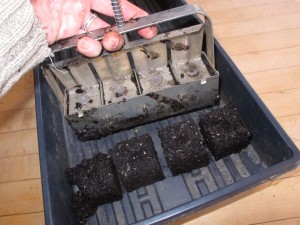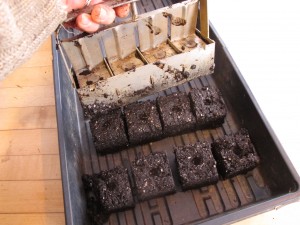An Alternative Way to Start Seedlings
A good gardener can start tomato seedlings in old yogurt tins – or anything else that will hold some soil mix. But most commonly gardeners buy plastic containers designed for starting seeds: each unit or “6-pack” has 6 little compartments that hold a few tablespoons of soil and has holes in the bottom for drainage. They fit inside trays that keep them from peeing on the table top. But there is an alternative, the handmade soil block, and it has several advantages.
I’ve been making soil blocks for at least 10 years, and like them. They are more work to make than using standard flats, so I use both – depending on the plants and the time I have to prepare them. Here’s what I do:
In a large plastic wheelbarrow I mix up the dry ingredients as described below. Then I mix up smaller quantities with water and press a special metal tool into a bin of the moistened mix. I squeeze the spring-loaded handle and 4 blocks pop out, ready to use.
Soil Block Recipe
Mix 10 quarts dry peat moss, 3 quarts sand and ¼ cup agricultural limestone (powdered, not pelletized is preferred, but either is OK)
Add ¼ cup each of and mix in :
Dried blood
Rock phosphate
Green Sand
Granite dust or Azomite (optional)
OR 1 cup Pro-Gro (or other) organic fertilizer
Add and mix in: 10 quarts Peat humus
10 quarts fine compost (your own or purchased)
10 quarts top soil (your own is preferred, but purchased is OK)
Place 4 quarts dry mix in a plastic basin or flat-bottomed container, and add about 1 quart water. Mix until gooey but firm, not watery.
I use a 2-quart plastic juice container for measuring out the dry ingredients. I mix the wet ingredients in storage container, the kind people use for storing sweaters. The block maker produces cubes that are about an inch and a half on a side, and have a small divot on the top where you can place a seed. A standard plastic tray or flat used for 6-packs of plants. The flat will hold 32 cubes. I push down hard on a big pile of the wet mix to make a nice dense cube.
Why bother with all this? As you know, seedlings left in a 6-pack will develop roots that become tangled and encircle the space they are growing in. When planting, you need to tease the roots apart so they can grow into the soil. This disturbance breaks roots and causes a plant to stop growing and rest for a while. In extreme conditions – such as big marigolds already blooming in a six-pack – you can lose over a week before the plant recovers.
In a soil block when the roots come to free air they stop growing. When you put the block in the ground, the roots can take off and start stretching on day one. Not only that, soil blocks are full of great organic nutrition. Most potting mixes are mostly peat moss, which has little nutritional value to a plant. In general, plants growing in soil blocks do better than the same seeds started in a sterile potting mix.
There is a popular myth that plants started indoors need a sterile potting mix. There is a fungal disease called “damping off” that is fatal to seedlings and that most gardeners know about – and fear. We learned not to use garden soil because of the possibility of damping off, but in years of using soil blocks that contain garden soil, I have never encountered it. I think having good rich growing medium promotes healthy plants, though I would never use pure soil as it compacts too much.
I planted celeriac (aka celery root) in mid-March. The seeds are tiny and hard to handle. I used a little plastic planting device I got from Johnnys Selected Seeds. They call it a hand seed sower and sell it for $4.25. It holds seeds, and allows one to jiggle and tap it to get seeds to drop off the tip of the device. I like it.
Whether using soil blocks or plastic six-packs, I plant 2 seeds per unit. That generally ensures me of getting at least one plant since most seeds germinate at a 90% rate or better, assuming that you don’t let them dry out. I use plastic covers over the top of the flats – they are clear domes sold for the purpose. I remove them once most of the seeds have germinated. And I snip off one of the two seedlings if both germinate.
I’ll plant my tomatoes this year on April 7 or 8. Both are “fruit days” on the Stella Natura calendar, which advises me on the proper phase of the moon and location of the stars and planets (www.stellanatura.com). Call me woo-woo, but it works! Planting seeds indoors is a lot of work, but it keeps me sane (I think) during the gray rainy days of spring.
Read Henry’s blog at https://dailyuv.com/
Thinking of Spring, Starting a Few Seeds
I’m not sick of winter yet. But I have to admit that recent warm, sunny days got me thinking about spring. I love to start seedlings in the house but recognize that it is still too early for most things. I have a couple of artichoke seedlings growing in a large pot, and will start some onions and peppers by mid-March.
The problem with starting seeds too early is that it is hard to meet the needs of your seedlings until the soil warms up enough to plant them outdoors. I have fluorescent lights and a nice plant stand. But as plants grow, they need bigger pots for their roots. As I start about 300 plants most years, I cannot give each of my babies its own 3- or 4-inch pot after they outgrow the six-packs many of them are started in. The solution? Start most things just six to eight weeks before they go outside – which for tomatoes and other frost sensitive plants is, for me, June 1oth even later.
Most commercial seed starting mixes are made of peat moss, perlite (a fluffy white substance that looks like Styrofoam), and some soluble chemical fertilizer. The assumption is that the mix will get plants off to a good start by providing a fluffy medium for young roots – but that you, the grower, will supply the “food” that your seedlings want after the first month.
After a month the chemical fertilizer will have either washed away or been used up. So what should an organic gardener do? There are fish or seaweed derived liquid fertilizers that you can dilute and add to the water you apply. They will supply the nitrogen, phosphorus and potassium found in a chemical fertilizer, and they will also supply calcium, magnesium, and many other chemical elements needed by your seedlings in small quantities.
Another solution, and one I favor, is to make a 50-50 mix of commercial potting mix with compost. My compost pile is frozen solid, but a good commercial compost such as Moo-Doo will do just fine – it will have healthy microorganisms in it. These bacteria and fungi help to process organic matter and turn it into chemicals that are easily absorbed and used by your seedlings.
Another technique is to make soil blocks using a small metal press that allows you to make 2-inch cubes of a packed soil mixture. This technique is more work, but provides high quality nutrition to your plants, and minimizes root shock when planted outdoors – seedlings grown in plastic six packs usually have tangled roots by the time they go outdoors, but plants started in soil blocks will not.
To make enough mix for about 300 blocs, mix the following ingredients in a wheelbarrow:
10 quarts of dry peat moss
1/4 cup limestone
1 cup azomite or granite dust (optional)
Then add and mix well:
10 quarts coarse sand,
10 quarts of peat humus,
1/2 cup colloidal or rock phosphate
1/2 cup green sand
1/2 cup organic blood meal
Finally add and mix well :
8 quarts of compost (your own or purchased)
8 8 quarts of garden soil or purchased topsoil.
The mix is somewhat dry, and needs to be moistened and used in small batches. For a start, mix 4 quarts of mix with 1-2 quarts of water, stirring it with your hand (wearing a rubber glove). It should be gooey, but firm, not watery. Experiment with it until you find just the right consistency.
To make the blocs, make a pile of the gooey stuff 4-5 inches deep in a recycling bin or other flat-bottomed container. Then compress it by squishing it with the block maker, which makes four 2-inch cubes at a time. Fill up the cavities of the blocker, and then get rid of any excess by pushing the block maker down and rotating it against the bottom of the bin.
You can eject the blocks with the squeeze of the spring-equipped handle into in a standard black plastic flat, which will just hold 32 blocks. Line up the rows of blocs so that they do not touch. Block makers are available from Johnny’s Seeds and the Fedco Seed Company. And if you don’t want to make your own mix, some companies such as Grow Compost of Vermont are making a mix suitable for block makers.
Starting seeds is not for everyone, but I love it. It keeps me from getting squirrely as winter morphs into mud season while waiting for the snow and ice to disappear. Give it a try if you haven’t.
Henry teaches gardening and pruning to groups and individuals. His web site is www.Gardening-Guy.com.






